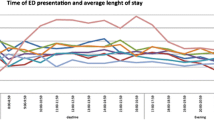Abstract
Rapid Medical Evaluation (RME) is a new Emergency Department (ED) process that initiates testing while patients are in the Waiting Room. Primary goal of this study is to assess the effectiveness of RME pathway on the patient flow through the ED. This was a retrospective, single site, cohort study of patients presenting to the ED 12 months before (PRE group) and 12 months after (POST group) RME implementation. The POST group was divided into those that underwent RME and those managed using standard care pathway (SCP). Data was collected from Electronic Health Record (EHR) database using SQL and consisted of time stamp data for discrete ED patient events. The following metrics were calculated for all ED encounters: Active ED Room Time, Boarding Time, Total ED Room Time, Total ED Time, and Door-to-Provider Time. Patients undergoing RME on average spent 90-min less in ED Treatment Room compared to SCP group and were evaluated by a provider 151 min earlier than if they had waited for an available ED Treatment Room. Implementation of RME helped reduce time patients spend in ED Treatment Room, improved patient throughput, and decreased Door-to-Provider time during the busiest times in the ED.




Similar content being viewed by others
Availability of data and material
Much of the data has Personal Health Information so cannot share the data.
Code availability
Code is specific to the analyzed data, and because the data contains Personal Health Information, it is not available for sharing.
References
Hoot NR, Epstein SK, Allen TL, Jones SS, Baumlin KM, Chawla N, Lee AT, Pines JM, Klair AK, Gordon BD, Flottemesch TJ, LeBlanc LJ, Jones I, Levin SR, Zhou C, Gadd CS, Aronsky D (2009) Forecasting emergency department crowding: an external, multicenter evaluation. Ann Emerg Med. 54(4):514-22 e19.
Lambe S, Washington DL, Fink A, Herbst K, Liu H, Fosse JS, Asch SM (2002) Trends in the use and capacity of California's emergency departments, 1990-1999. Ann Emerg Med. 39(4):389-96.
Singer AJ, Thode HC, Jr., Viccellio P, Pines JM (2011) The association between length of emergency department boarding and mortality. Acad Emerg Med. 18(12):1324-9.
Derlet RW (2002) Overcrowding in emergency departments: increased demand and decreased capacity. Ann Emerg Med. 39(4):430-2.
Derlet RW, Richards JR (2000) Overcrowding in the nation's emergency departments: complex causes and disturbing effects. Ann Emerg Med. 35(1):63-8.
Nestler DM, Fratzke AR, Church CJ, Scanlan-Hanson L, Sadosty AT, Halasy MP, Finley JL, Boggust A, Hess EP (2012) Effect of a physician assistant as triage liaison provider on patient throughput in an academic emergency department. Acad Emerg Med. 19(11):1235-41.
Ramsey Z, Palter JS, Hardwick J, Moskoff J, Christian EL, Bailitz J (2018) Decreased Nursing Staffing Adversely Affects Emergency Department Throughput Metrics. West J Emerg Med. 19(3):496-500.
Wilson SP, Connolly K, Lahham S, Subeh M, Fischetti C, Chiem A, Aspen A, Anderson C, Fox JC (2016) Point-of-care ultrasound versus radiology department pelvic ultrasound on emergency department length of stay. World J Emerg Med. 7(3):178-82.
Kankaanpaa M, Raitakari M, Muukkonen L, Gustafsson S, Heitto M, Palomaki A, Suojanen K, Harjola VP (2016) Use of point-of-care testing and early assessment model reduces length of stay for ambulatory patients in an emergency department. Scand J Trauma Resusc Emerg Med. 24(1):125.
von Elm E, Altman DG, Egger M, Pocock SJ, Gøtzsche PC, Vandenbroucke JP, for the SI (2007) The Strengthening the Reporting of Observational Studies in Epidemiology (STROBE) Statement: Guidelines for Reporting Observational Studies. PLOS Medicine. 4(10):e296.
Rossum GV, Drake FL (2009) Python 3 Reference Manual. Scotts Valley, CA: CreateSpace.
Team RC (2019) R: A Language and Environment for Statistical Computing Vienna, Austria [Available from: https://www.R-project.org/.
Walt Svd, Colbert SC, Varoquaux G (2011) The NumPy array: a structure for efficient numerical computation. Computing in Science & Engineering. 13(2):22-30.
McKinney W (2010) Data structures for statistical computing in python. Proceedings of the 9th Python in Science Conference Austin, TX. p. 51–6.
Gautier L (2020) rpy2 - R in Python [Available from: https://github.com/rpy2/rpy2.
Hunter J (2007) Matplotlib: A 2D Graphics Environment. Computing in Science & Engineering. 9:90-5.
Waskom M, Botvinnik O, Hobson P, Warmenhoven J, Cole J, Halchenko Y, Vanderplas J, Hoyer S, Villalba S, Quintero E (2012) Seaborn: statistical data visualization. https://seaborn.pydata.org.
Welch SJ (2010) Twenty years of patient satisfaction research applied to the emergency department: a qualitative review. Am J Med Qual. 25(1):64-72.
Wuerz RC, Milne LW, Eitel DR, Travers D, Gilboy N (2000) Reliability and validity of a new five-level triage instrument. Acad Emerg Med. 7(3):236-42.
Bell CM, Redelmeier DA (2001) Mortality among patients admitted to hospitals on weekends as compared with weekdays. N Engl J Med. 345(9):663-8.
Author information
Authors and Affiliations
Contributions
JF conceived the study, designed the trial, and obtained IRB approval. SAM constructed SQL algorithm to obtain the necessary data. JF did data cleaning, analysis, and graphing. JF drafted the manuscript and all authors contributed substantially to its revisions. JF takes responsibility for the paper as a whole.
Corresponding author
Ethics declarations
Ethics approval
Study was deemed exempt by the local Institutional Review Board (IRB).
Conflicts of interest/Competing interests
Neither author has any conflict of interest.
Additional information
Publisher's Note
Springer Nature remains neutral with regard to jurisdictional claims in published maps and institutional affiliations.
This article is part of the Topical Collection on Patient Facing Systems.
Rights and permissions
About this article
Cite this article
Furmaga, J., McDonald, S.A. Impact of Rapid Medical Evaluation on Patient Flow in an Urban Emergency Department. J Med Syst 45, 63 (2021). https://doi.org/10.1007/s10916-021-01741-8
Received:
Accepted:
Published:
DOI: https://doi.org/10.1007/s10916-021-01741-8




